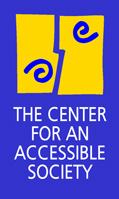
DISABILITY
ISSUES
INFORMATION
FOR
JOURNALISTS
TOPICS
ABOUT
THE CENTER
Section 508 is a part of the Rehabilitation Act Amendments of 1998. The Rehabilitation Act requires that electronic and information technology developed, procured, maintained, or used by the Federal government be accessible to people with disabilities.
Section 508 was originally added to the Rehabilitation Act in 1986; the 1998 amendments significantly expand and strengthen the technology access requirements in Section 508 -- the 1986 version established non-binding guidelines for technology accessibility, while the 1998 version calleld for binding, enforceable standards.
The Access Board was the agency charged with developing the access standards. It issued the final standards on December 21, 2000, which take effect 6 months after the issuing date.
After June 21, 2001, federal agencies will have to use these standards in all their electronic and information technology acquisitions. The new version of Section 508 also establishes a complaint procedure and reporting requirements, which further strengthen the law.
What does the law mean by "accessible'?
A technology system is accessible to people with disabilities if it can be used in a variety of ways that do
not depend on a single sense or ability. For example, a system that provides output only in audio format would not be accessible
to people with hearing impairments, and a system that requires mouse actions to navigate would not be accessible to people who
cannot use a mouse because of a dexterity or visual impairment. Section 508 focuses on the overall accessibility of electronic and
information systems, not on providing accommodations at individual worksites. Section 501 of the Rehabilitation Act requires
Federal agencies to provide reasonable accommodations for individuals with disabilities; it generally covers individual worksites
but not overall technology systems. Even with an accessible system, individuals with disabilities may still need specific
accessibility-related software or peripheral devices as an accommodation to be able to use it. For example, in order to use an
accessible word-processing program, a person who is blind may need add-on software that reads text aloud; if the
word-processing program could not be made compatible with a screen-reading program, it might not be accessible.
Does this mean Web sites can't have graphics?
Not at all. Actually, designing an accessible Web site is not as difficult as most people believe. Often it is a matter of identifying
graphics, elements, frames, etc. For example, HTML code already provides the "Alt Text" tag for graphics -- which some designers
simply forget or ignore.
Won't accessible Web sites be less appealing?
On the contrary, accessible sites have several advantages. For one thing, some people turn off graphics so sites will load faster.
Without "alt" tags, graphics-intense sites may be unusable. Also, with the growth of PDAs, and even Web site content delivered
to cell phones, having text- based content is becoming more important. Because the screens on such devices are so small, graphics
will probably never be a viable option. So the busy executive, waiting in an airport, who wants to check her stock portfolio on her
cell phone isn't going to turn to the graphics-only site. Furthermore, with the growth of voice technology the harried commuter
can have the headlines from his favorite news site read to him, but only if there is a text-based content. Finally, if a digitized video
has synchronized captions, the text can be searched. Did you ever try to find a particular scene from your favorite video? If you
want to find the famous restaurant scene from the captioned version of "When Harry met Sally" search on "I'll have what she's
having" and you're there.
The Americans with Disabilities Act's provisions have made a considerable impact on our society, opening
many doors to employment, educational, and recreational opportunities that
had previously been closed.
But a few years after passage of the ADA, it
became clear that the provisions of the ADA had not contemplated the huge
technological revolution that was enveloping our country. Although
individuals with disabilities were finally gaining some physical and
communications access to government and business employment and services,
access to burgeoning telecommunications and information technologies
remained elusive.
When, in the early 1990's, Congress began considering
sweeping changes to our nation's telecommunications policies, disability
advocates saw a ripe opportunity to have this need addressed. As a
consequence, passage of the Telecommunications Act of 1996 brought with it
the arrival of a new civil rights law for individuals with disabilities:
Section 255.
Section 255 of the Telecommunications Act
of 1996, Pub. L. 104-104, codified at 47 U.S.C. Sec. 255, requires
telecommunications services and equipment to be accessible, where readily
achievable. Where not readily achievable, such services and equipment must
nevertheless be compatible with existing peripheral devices or specialized
customer premises equipment used to achieve access, again where this is
readily achievable. Readily achievable is defined as "easily accomplishable
and able to be carried out without much difficulty or expense." The
legislation contemplates that manufacturers and service providers will
consider access needs during the design, development and fabrication of
their offerings, so that expensive and burdensome retrofitting for access
will not be necessary.
Section 508 of the Rehabilitation Act was the next logical step in the
progression of these various Federal civil rights laws. Much of the earlier
legislation focused on access to what has traditionally fallen into the
field of "telecommunications." But our nation is now witnessing a rapid
convergence of these traditionally telecommunications technologies with new
and advanced electronic and information technologies. As our Federal
government becomes increasingly reliant on these convergent technologies,
Section 508 will ensure that individuals with disabilities will be able to
reap their many benefits.
Q and A:
Section 508 of The Workforce Investment Act of 1998 requires Federal agencies to have internet sites that are accessible to all users -- including people who cannot see or hear.
From Electronic and Information Technology Access Advisory Committee
Final Report, May 12, 1999
Overview.
SEE ALSO...
"One year and counting: Section 508" [Federal Computer Week, June 24, 2003]